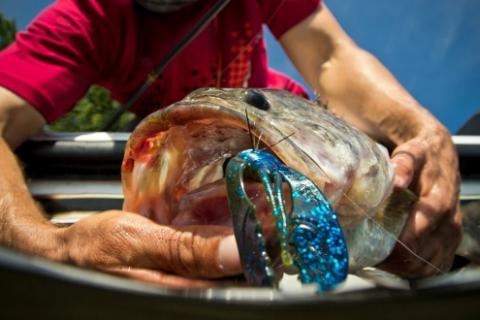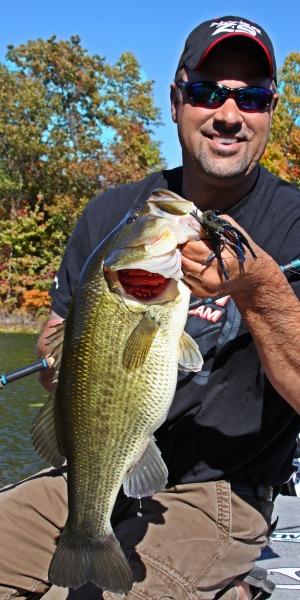
Mark Zona doesn't have the time or tolerance to mess with small fish. He’s got a deal pinned down that involves big bass jigs, stout rods, offshore vegetation, and monster largemouth.
He’s aware that he could crash and burn on some days, but on those days that the stars line up, he will see plenty of fish—and won’t catch one under four pounds.
Weather Wisdom
Zona cares little about water temperatures, but he studies barometric pressure religiously. “I want the weather as nasty as possible. Rain, sideways wind, that’s when they crush a big jig. You can catch them on it everyday, but your numbers increase when under low pressure,” Zona said.
Hitting the Salad Bar
This technique is productive on southern lakes like Toledo Bend, Lake Guntersville, and Lake Fork, but Zona was amazed to find that it works on clear grass lakes in the Midwest and to the north. He believes that these reservoirs have a largemouth population that holds in deep-water year round. These fish are especially susceptible to the big jig.
Zona will start looking in 15- to 24- feet of water for a defined weed edge in cabbage, milfoil, or coon tail. He utilizes a Humminbird Onix with 2d imagery to look for any irregularity in the deep vegetation. It could be a 3-foot outcropping of grass on an already defined weed line, a spot where cabbage meets milfoil, some football sized rock mixed in or—even better—a pod of bluegills.
Upon landing his first quality fish, Zona kicks a marker buoy over the side and punches a waypoint allowing him to study exactly where that fish came from. He then uses 360 degree imaging to present his bait properly in front of him.
The Bluegill Connection
Whether fishing at home or abroad, Zona always pays keen attention to where the bluegill fishermen are located. After all, there’s no sense in following the other bass boats just to divide the same fish.
At a past tournament on Lake Champlain, the water clarity on Ticonderoga was very clear and the grass grew out to 16 feet. “I saw a pod of little fingerling blue gills and I saw a flash—all those bluegills just sprayed. I dropped a jig down there and got bit. I went along, saw another pod, dropped down, got another bite,” Zona started. “I grabbed a 1 oz. jig and started plunking it down that weed edge where other anglers had fished 3/8 and 1/2oz jigs—yet I was catching quality fish. It’s amazing what that rate of fall does to those fish.”
Zona will snap the jig sharply six times before it goes into the next likely spot. “I’m trying to make that look like a bluegill shooting through the holes in the grass,” He said. Mark is aware that if he puts his bait in 300 holes, he might only get 10 solid bites.
Tools of the Trade
He’ll flip a green pumpkin Strike King Structure Jig or Hack Attack Jig weighing ¾ to 1 ¼ oz. paired with Rage Craw or KVD Chunk trailer. He uses chartreuse Spike-It on the trailer to replicate the hues of a bluegill. He’ll also bend the gap of the hook out one degree to improve his hooking percentage.
Zona likes a G-Loomis rod strung up 65-lb. braid and another with 20-lb. fluorocarbon. A stiff rod with a soft tip is key for moving big fish and a reel with a high gear ratio is needed to take up line quickly.
Most bites feel like the jig is welded to the bottom of the lake or hung in a tree. The majority of them come on the initial drop, so Zona keeps his rod at 9 o’clock—ready and waiting to cross their eyes once he feels pressure.
While this tactic may not produce a boat full of fish, it’s one heck of a bargain for some of the biggest bass in the lake.
- 9137 views

